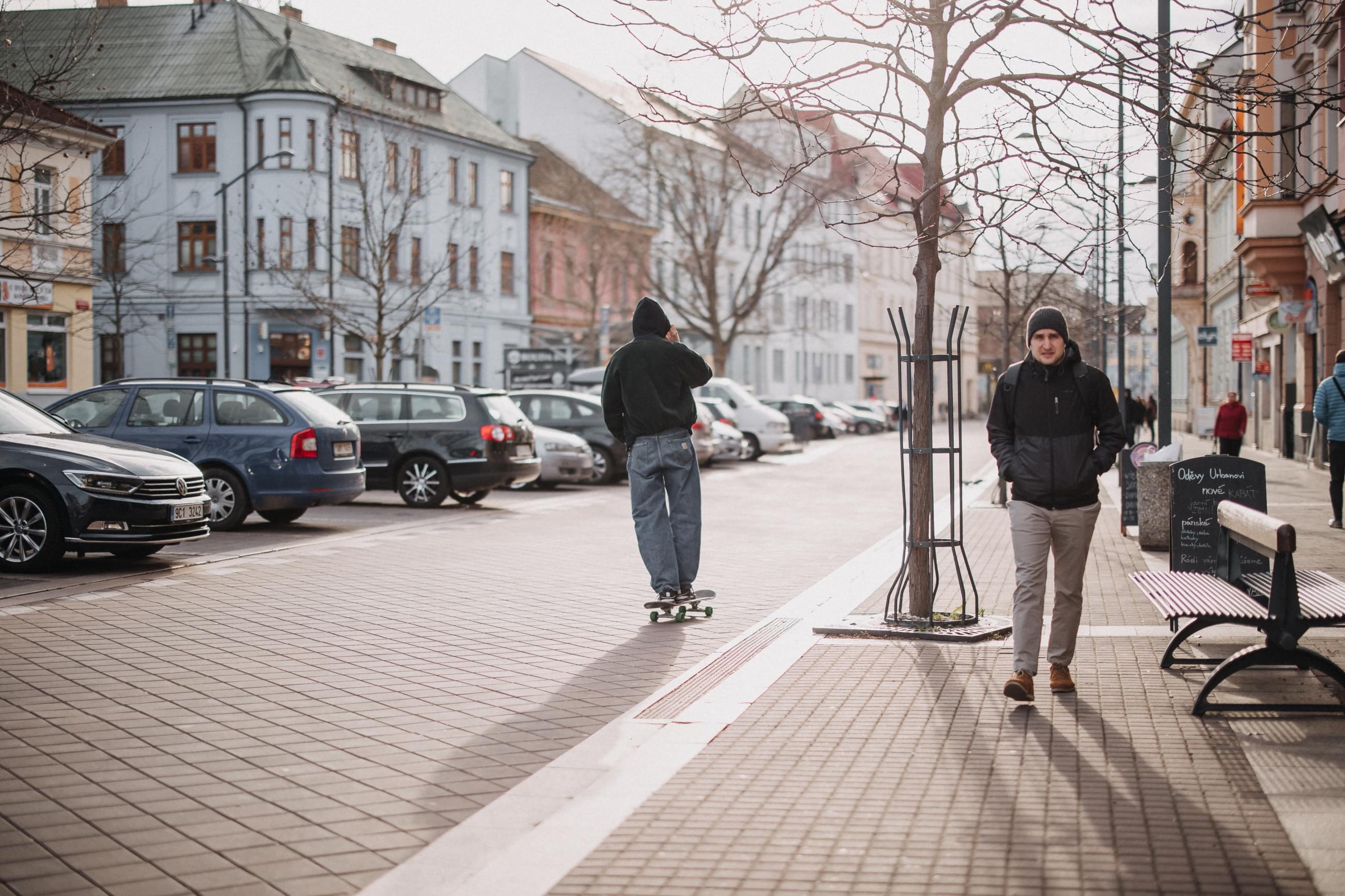Echoes of the Procházka Festival - Can we look at Budweis from a different perspective?
In the second week of March, as part of the candidacy of České Budějovice for the European Capital of Culture, we organized a walking festival with the theme - relationship to place, relationship to the city. We wanted to offer the widest possible spectrum of perspectives through which to look at our city. The themes of the individual walks covered history, community activity on the estate and nature in the city. It showed the barriers faced by people with visual or hearing impairments. There was also the perspective of people on the city from the LGBTQI+ group or the skateboard community.
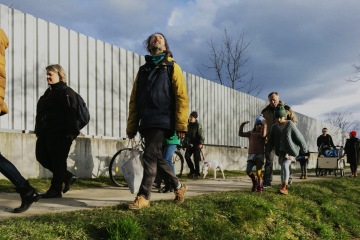
Photo: Nika Brunová
How was the Procházka Festival in numbers?
-
The festival took place over 5 days.
-
In total, we had 16 walks with guides who are part of local organisations or are prominent figures in our region.
-
During this time we registered 331 visitor bookings. We were able to reach visitors of different age groups. However, random passers-by also joined in during individual walks.
Programme of the Procházka (Walking) Festival
The Walking Festival was divided thematically into three groups - historical walks, walks with a public space theme and walks focused on the communities that live in the city.
The historic walks transported visitors to the past. Their guides talked about the time of the founding of the royal city on the Vltava River, others about the history of the city's houses and their owners, or about the places where a theatre used to stand in the past, of which there are no traces today. Historical walks promote awareness of the development of the town and knowledge of the historical context. Do you know the stories of the streets and buildings you pass by every morning on your way to work? Do you know how our city got its current shape and why? We believe that through knowledge of the historical context we can create projects that will not disrupt the continuity of the city, but at the same time bring new impulses to its further development.
Every day we walk through the public space, stopping to look for cultural or sporting events. Or we seek a moment of peace in a green park. The walks about public space explored the boundaries of the city and nature and the possibilities of using public space. Are we interested in what happens in it? Are we looking after it? Do we think of it as our common space that we can be part of? These and other related questions were answered in this block of walks.
The last set of walks looked at the city from the point of view of its inhabitants. Is the space of the city accessible to all? Do all groups of its inhabitants feel safe in it? What are we doing to ensure that this is the case? These questions were raised during the walks with people for whom the topic of the inaccessibility of the city's limits is an almost daily issue.
Each of the walks followed a different thematic layer that we want to cover in the Bid Book (České Budějovice's application for the European Capital of Culture competition).
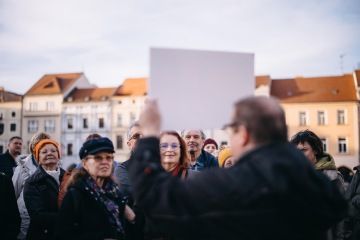
Photo: Pavel Balek
History - relationship to place and awareness of context
A historical walk with Milan Binder drew visitors into the stories of the houses and their owners. The walk went from Přemysl Otakar II Square, through U Černé věže Street, Hroznovka Street and Krajinská Street to Mariánské náměstí and back to the square through Česká Street. Thanks to the historical photographs of the places and the knowledge of the guide, the visitors of the walk had the opportunity to compare the development of the city, hear the stories of individual houses, personalities and patriots.
Writer Jan Štifter told the story of Budějovice at the turn of the 19th and 20th centuries in the historical walk "Go to the Café Groll brothel". He took the visitors to the places he deals with in his successful book novel Café Groll.
The walk "How Hirzo founded the royal city on the Vltava River" dressed visitors in Dominican traveling cloaks. The talk was about the founding of the royal city on the Vltava River, when the construction actually began, how the surveying took place, where the building materials were imported from, who paid for the construction of the walls, the name of the first prior of the Dominican monastery and many other interesting facts. Our guide was historian Miroslav Mareš.
The Gymnasium Česká opened its doors to us, and the current headmaster Antonín Sekyra and the students of the Gymnasium gave us a tour. The building, originally a Latin gymnasium, has been through history, several interesting personalities and therefore hides many stories. In the past, the site was home to craftsmen's dwellings, a spa, a mint and a saltworks.
František Řihout, the dramaturge of the South Bohemian Theatre, guided the visitors through the places where the theatre used to stand in the past and today there is no trace of it. Since 1819, a theatre building has stood on the Malše embankment, but during the German Protectorate during World War II it was even extended with an extension. But the walk went to other places as well - to Piaristické náměstí (Piarist Square), the talk was about the theatre in the church and the gym.
Protectorate Budweis was presented by historian Jan Ciglbauer. He told the visitors about the vanished Jewish community, about the interrogation rooms of the Nazi authorities, about innocent victims and about the perpetrators of ancient crimes from the end of the war.
University of South Bohemia teacher Hynek Látal and his university colleague Nikola Špůrová prepared a walk for visitors entitled Thirty Years in Stromovka - What's Left? Thirty years ago, the idea of wood-sculpting symposiums was conceived, which have been regularly held in České Budějovice since 1993 in six editions and whose results have been planted in the forest park. During the walk, Látal and Špůrová talked about the works of important representatives of Czech art of the second half of the 20th century and the works of foreign authors.
The last historical walk led to the important houses of the Czech/Budweis architecture of the 1970s - Prior-Metropol-Gerbera. What were they and what are they today? How did České Budějovice change and what was left out of the plans and construction? This is what architect Martin Augustin told us.
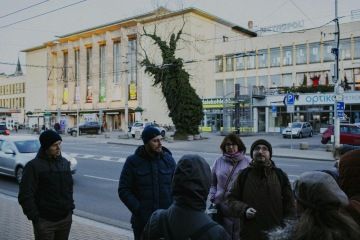
Photo: Nika Brunová
Public space for all
Tomáš Smrž from the Cassiopeia eco-centre led a walk called "Where does the city end and nature begin?". From the Great Dam, along the Mill Drain, it was all the way to the centre, to Budweis, the former mill where the drain flows into the Vltava. Although a relatively large part of the city's built-up area was walked through, participants were constantly surrounded by wild nature. The theme, however, was not only the discovery and awareness of urban nature, but also the introduction of different approaches to its cultivation or freedom.
The walk "Skateboarding and the City" posed questions such as:
- Is it good to integrate leisure activities into urban planning?
- What are the benefits of such activities?
- Why are skateboarders good architects?
- How does the whole process of designing "skate-friendly" places work?
- Are there still ingrained prejudices in the Czech Republic?
The guide Martin Hrouda, co-founder of the architecture studio U / U, has been dealing with these topics for a long time. Studio U / U is dedicated to incorporating freestyle sports into urban planning to create the most attractive social space for riders and the wider public. It is made up of architects and engineers who share a passion for skateboarding. They like to spend their free time in public spaces, they pay attention to details and have a sense of place. The solutions designed by the studio thus serve not only for skateboarding, but also as a public space that encourages social interaction. You will be able to find out how such places look and function during the Skateholders #1 event from the 20th-22nd of April 2023.
Can public space be redesigned without big visions and dreams? Do stories belong in the city? For us, big dreams and plans are behind every successful project! The educational walk Everyday Fantasy of Budweis encouraged visitors to let their imagination run wild. Thanks to the Na Tahu association, the walk themed local literary works, magic and enchantment. The association focuses on storytelling through board games, especially the Dungeons & Dragons adventure.
What life in the city can look like
Do you know the Máj Community Centre - Salesian Youth Cultural Centre? That's where one of our first festival walks took place. Guide Ilona Paulátová works at the center as a coordinator of volunteers and interns. Over a cup of coffee, she talked about the activities of the Salesian Centre, its history and its work in the middle of the estate.
The LGBTQI+ walk was led by Krišpína Nohejlová, founder of local community group BUDQueer, together with members of South Bohemian Lambda. Visitors learned about the historical context that queer people have been through, what it was like in České Budějovice and what the situation is now. As part of the walk, visitors were involved in the process of creating a map of "queer friendly businesses" and labeling them. After the festival, we received a nice message from Krišpína: "After the walk, I arranged a possible collaboration with Konsent and their network of friendly bars. Our map will connect with this national project, and will be actively pursued further."
The world around us is full of sounds. How do you function in the city if you can't hear them? Visitors learned a lot about deafness, sign language, and the barriers deaf people face from members of the organization Silent World, Pavla Třísková and Lucie Novotná. We ended the walk at the South Bohemia Research Library, where participants learned about the Silent Line project, which serves as a quick connection between a translator and a person with a hearing impairment.
The walk (Not)Seeing the City gave an insight into the life of a person with a visual impairment. What pitfalls await them on the streets, which gadgets do they use and how can you help them? Šarlota Hambergerová, director of Together with You - a social enterprise for the visually impaired, guided us on the walk.
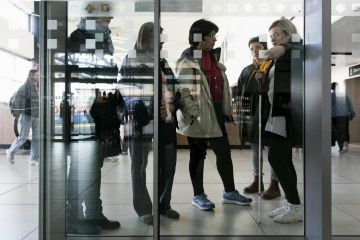
Thanks
Dozens of people and organizations were involved in the realization of the Procházka Festival and supported the candidacy of České Budějovice for the European Capital of Culture.
We are very happy about the list of all those involved, which we would like to share!
Our tour guides were:
- Milan Binder - historian, regional photographer and writer
- Jan Štifter - journalist and writer
- Miroslav Mareš - historian
- Antonín Sekyra - director of Gymnasium Česká
- František Řihout - dramaturg of the South Bohemian Theatre
- Jan Ciglbauer - historian, member of Paměti národa
- Hynek Látal - university teacher at the University of South Bohemia
- Martin Augustin - architect, university teacher
- Tomáš Smrž - coordinator of educational activities of the Cassiopeia eco-centre, project manager
- Martin Hrouda - architect, co-founder of the architectural studio U / U
- Jiří Korčák - member of the gaming group Na Tahu
- Ilona Paulátová - coordinator of volunteers and interns of the Community Centre Máj - Salesian Youth Cultural Centre
- Krišpína Nohejlová - founder of the local community group BUDQueer
- Pavla Třísková and Lucie Novotná - members of the organization Silent World
- Šarlota Hambergerová - director of Together with You
